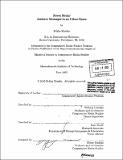| dc.contributor.advisor | William Uricchio and Kurt Fendt. | en_US |
| dc.contributor.author | Murthy, Rekha (Rekha S.) | en_US |
| dc.contributor.other | Massachusetts Institute of Technology. Dept. of Comparative Media Studies. | en_US |
| dc.date.accessioned | 2009-08-27T14:09:47Z | |
| dc.date.available | 2009-08-27T14:09:47Z | |
| dc.date.copyright | 2005 | en_US |
| dc.date.issued | 2005 | en_US |
| dc.identifier.uri | http://dspace.mit.edu/handle/1721.1/39182 | en_US |
| dc.identifier.uri | http://hdl.handle.net/1721.1/39182 | |
| dc.description | Thesis (S.M.)--Massachusetts Institute of Technology, Dept. of Comparative Media Studies, 2005. | en_US |
| dc.description | Includes bibliographical references (v. 2, leaves 126-137). | en_US |
| dc.description.abstract | Ambient street media are the media of our everyday lives in cities. Manifested in bits and fragments on the surfaces of the streetscape, these media often escape our notice - tuned out as visual clutter or dismissed as unimportant. Yet, attentive viewing and analysis reveal much about the local culture of communication and expression. This thesis blends empirical and theoretical methodologies in a year-long photographic study that takes a fresh look at the concepts and realities of "media," "the city," and "the everyday," and sets several disciplines in interaction with one another. Ambient street media include news racks, traffic and street signs, storefronts, sandwichboards, graffiti, stickers, murals, and flyers. This is in contrast to conventional notions of "the media" as one-to-many communication modalities consumed primarily in the domestic space, particularly television, radio, major newspapers, and the Internet. Studies of media in everyday life typically address these mass media, passing over ambient street media for any detailed examination. By examining both the explicit and implicit facets of street communications, this study elevates their importance in a number of disciplines, from cultural studies to urban design and planning. For example, we find much to counter postmodern anxieties about cities. | en_US |
| dc.description.abstract | (cont.) While evidence of globalization and the prioritization of government and corporate interests over those of local entities and autonomous individuals are easily found, the ecology of street media includes a vibrant array of individual communications. Currently, much of the media made by individuals are unauthorized to appear where they do. But in the commercial area of Central Square, in Cambridge, Massachusetts, they are accorded a high degree of tolerance by local authorities, making this a unique laboratory in which to see what happens when streetscape surfaces are accessible to many. The streetscape can be viewed as a communication medium in itself, special for its direct accessibility and affordability as well as the immediacy with which messages posted there can be received. Urban planners who seek to design spaces that give people a sense of place are encouraged to more equitably apportion space among government, commercial, and individual interests and add surfaces that are more accommodating to a wider array of inscriptions. | en_US |
| dc.description.statementofresponsibility | by Rekha Murthy. | en_US |
| dc.format.extent | 2 v. (137 leaves, [98] leaves of plates) | en_US |
| dc.language.iso | eng | en_US |
| dc.publisher | Massachusetts Institute of Technology | en_US |
| dc.rights | M.I.T. theses are protected by
copyright. They may be viewed from this source for any purpose, but
reproduction or distribution in any format is prohibited without written
permission. See provided URL for inquiries about permission. | en_US |
| dc.rights.uri | http://dspace.mit.edu/handle/1721.1/39182 | en_US |
| dc.rights.uri | http://dspace.mit.edu/handle/1721.1/7582 | en_US |
| dc.subject | Comparative Media Studies. | en_US |
| dc.title | Street media : ambient messages in an urban space | en_US |
| dc.type | Thesis | en_US |
| dc.description.degree | S.M. | en_US |
| dc.identifier.oclc | 62763151 | en_US |
